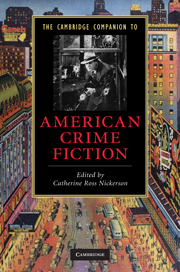Book contents
- Frontmatter
- 1 Introduction: The satisfactions of murder
- 2 Early American crime writing
- 3 Poe and the origins of detective fiction
- 4 Women writers before 1960
- 5 The hard-boiled novel
- 6 The American roman noir
- 7 Teenage detectives and teenage delinquents
- 8 American spy fiction
- 9 The police procedural in literature and on television
- 10 Mafia stories and the American gangster
- 11 True crime
- 12 Race and American crime fiction
- 13 Feminist crime fiction
- 14 Crime in postmodernist fiction
- Guide to reading
- Index
2 - Early American crime writing
Published online by Cambridge University Press: 28 September 2010
- Frontmatter
- 1 Introduction: The satisfactions of murder
- 2 Early American crime writing
- 3 Poe and the origins of detective fiction
- 4 Women writers before 1960
- 5 The hard-boiled novel
- 6 The American roman noir
- 7 Teenage detectives and teenage delinquents
- 8 American spy fiction
- 9 The police procedural in literature and on television
- 10 Mafia stories and the American gangster
- 11 True crime
- 12 Race and American crime fiction
- 13 Feminist crime fiction
- 14 Crime in postmodernist fiction
- Guide to reading
- Index
Summary
In 1851, Herman Melville confessed to possessing a criminal democratic philosophy. He worried, however, that his chosen interlocutor, Nathaniel Hawthorne, might not appreciate this subversive formulation and instead cleave to an “aristocracy of the brain.” “So,” he wrote Hawthorne, “when you see or hear of my ruthless democracy on all sides, you may possibly feel a touch of a shrink, or something of that sort.” Melville presumed that Hawthorne's “shrink” would stem not merely from intellectual or class prejudice but from a moral repugnance, admitting, “It is but nature to be shy of a mortal who boldly declares that a thief in jail is as honorable a personage as Gen. George Washington.”
Melville should have been nervous. His equation between the thief and the founder promoted a version of America and its literature that many writers in Hawthorne's circle found deeply objectionable. While Melville suggested that a truly “ruthless” America would embrace egalitarianism through sympathy with the criminal, authors, such as Hawthorne's favorite literary critic, Edwin Whipple, attacked popular crime writing precisely because it promoted this leveling identification. He lambasted what he called the “Romance of Rascality” for teaching “the fact that a man excites moral reprobation is his claim upon our sympathy” and that “the old gentlemen of '76 . . . fought for an equality in evil as well as good.”
The following essay sketches a brief history of this “equality in evil.” It tracks popular American crime writing from seventeenth-century execution sermons through eighteenth-century novels and then concludes with the courtroom journalism that electrified the antebellum era. In short, it examines how debates over sympathy for the criminal structured these texts and, ultimately, shaped Melville's “ruthless” American literature.
- Type
- Chapter
- Information
- The Cambridge Companion to American Crime Fiction , pp. 5 - 16Publisher: Cambridge University PressPrint publication year: 2010
- 13
- Cited by

